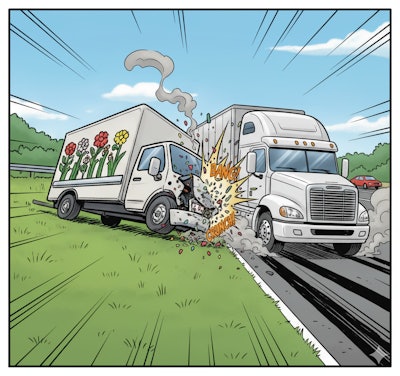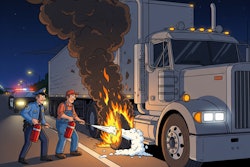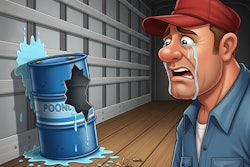
John Doe was rolling down I-70, and would normally have been totally relaxed – except that, today, he was pulling double trailers. Because most of his runs involved towing a single trailer, he kept reminding himself that he had to make lane changes gradually. “Those 4-wheeler drivers nearby get antsy about the shenanigans of a dog-tracking rear box,” he kept telling himself.
At least the conditions were ideal, with a bone-dry highway surface, light traffic and a generous divider between the opposing lanes. To minimize any chance he’d need to maneuver violently or jam on the brakes, Doe stayed 5 mph below the lower limit posted for trucks. Just to forestall any moments of carelessness, Doe took a sip of his coffee and followed with a lime-flavored Gummy Bear.
Remaining alert, Doe continually swept the highway with his eyes. He was in the left lane, having just passed a pickup truck in the right lane. He’d left the pickup driver a generous following distance and was ready to gently swing back to the right when his alert eyes suddenly caught sight of a straight-job rumbling across the median toward his lane. Alert to the fact that the entire rig had effective ABS, Doe swung to the right as fast as he could without creating instability, and simultaneously began hard, steady braking. Alas, his Herculean effort wasn’t enough. The front bumper of the wayward flower delivery truck still managed to find Doe's passenger-side saddle tank.
When he stopped and got out to look, it became clear that the pickup had time to stop when he slammed on the brakes, but that Doe’s truck was badly damaged and the Class 6 truck was a shambles. Fortunately, both drivers had worn their seat belts and were little the worse for wear. Doe, and the ABS system, had managed to keep both trailers in lane and right side up.
Was this accident preventable?
Doe received a preventable accident-warning letter from his safety director but refused to accept its conclusion that he must have been running too fast for conditions and was inattentive. He asked the National Safety Council’s Accident review committee to render a decision on his guilt or innocence.
NSC quickly ruled in Doe’s favor, pointing out that he’d likely seen the oncoming vehicle and had reacted as soon as it was obvious it would end up in his lane. He’d also reacted skillfully with an appropriate combination of steering and hard braking, and clearly had not been running at a speed that contributed to the calamity.










